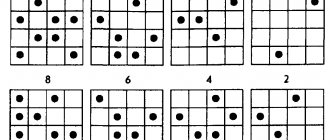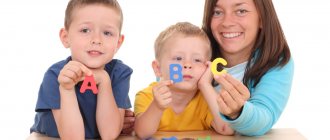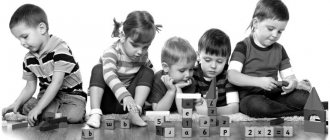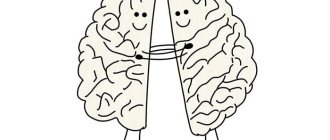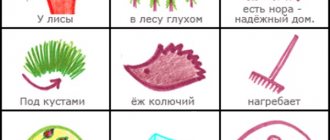Ascertaining experiment
In order to determine the level of development of coherent speech in preschool children, we conducted a testing experiment on the basis of the compensatory kindergarten kindergarten No. 87 in the city of Yaroslavl.
Children from the older group took part in the experiment: an experimental group (10 people in their sixth year of life) and a control group (10 people in their sixth year of life).
We developed a methodology for examining children’s coherent speech based on the option proposed by T.I. Grizik and L.E. Tymoshchuk.
According to researchers, the formation of coherent speech should be given one of the central places in the development of a child, because Possession of a variety of coherent speech skills allows the child to fully communicate with peers and adults.
Coherent speech includes two linguistic forms - dialogue and monologue. The development of both forms plays a leading role in the process of the child’s speech development and occupies a central place in kindergarten.
As part of this experiment, the examination of coherent speech included a study of the characteristics of children's dialogical communication and narrative statements.
I. When studying dialogic communication, the speech therapist clarifies its features in specially organized conversations.
During September 2007, we held 3-4 conversations “How I spent my summer” as part of educational cycle events. The interviews were conducted in subgroups. Children participated in them at their own request. We observed each participant in the conversation and recorded the following characteristics:
Initiative. The child speaks out on his own initiative (2); at the suggestion of the teacher (1); does not protrude (0).
Topics of children's statements (games, entertainment, incidents, finds, etc.).
The ability to answer a specific question without being distracted from its content. The child answers (2); distracted (1); not responding (0).
The ability to ask questions (to the teacher). The answers of only those children who asked questions on their own initiative were recorded; children's questions were recorded.
The ability to listen to your interlocutor . We recorded how the child listened (attentively - inattentively, interrupting - not interrupting, etc.). All data was entered into the Protocol (see Appendix 3).
II. Studying the features of narrative statements.
Material for examination: pictures depicting characters from the fairy tale “Turnip”.
Examination procedure: The examination was carried out in an individual form. The teacher removed one of the pictures (for example, a picture of a dog). The rest were scattered on the table. The teacher said to the child: “Do you know the fairy tale “Turnip”? I brought pictures depicting the heroes of this fairy tale. But they got mixed up in my bag. Arrange the pictures in the order in which the characters appeared in the fairy tale “Turnip”. If the child noticed the absence of one of the characters, the teacher gave the picture. After completing the task, the teacher asked the child to retell the fairy tale.
Analysis of the results: During the study, the following characteristics were taken into account: the ability to build a sequence and the ability to recreate the sequence in a statement. The following were recorded:
Subsequence. The child laid out the pictures in the correct sequence and noticed the absence of one of the characters (2); laid out the pictures in the correct sequence, but noticed the absence of one of the characters only during the retelling (1); violated the sequence, did not notice the missing hero even during the retelling (0).
Retelling. The child retold the fairy tale in full (2); missed (confused) the sequence of events in the fairy tale (1); did not retell the fairy tale (0).
Smoothness of speech. The presence (“+”) and absence (“—”) of long pauses.
The obtained data were entered into the Protocol (see Appendix 3).
During an experimental examination of the coherent speech of children of senior preschool age with mental retardation, we identified the following features:
I. Dialogical communication:
- low initiative in dialogical communication;
- narrow topic of conversation;
- grammatical errors;
- difficulties in selecting the correct lexical units;
- inability to listen to the interlocutor.
II. Features of narrative statements:
- difficulties in correctly constructing sentences;
- children compose simple, uncommon sentences and practically do not use complex syntactic structures;
- difficulty in following the sequence of events;
- difficulties in understanding cause-and-effect relationships;
- difficulties in updating the previously read content of a fairy tale or story.
Thus, the data from the ascertaining experiment revealed a low level of development of coherent speech in children with mental retardation. The identified features confirm the need for further formation and development of both dialogic and monologue forms of speech in preschool children.
Article:
To date, the speech activity of children with mental retardation has not been studied enough.
The main researchers in this area are N. Yu. Boryakova, L. V. Yassman, R. I. Lalaeva, E. V. Maltseva, R. D. Triger. Scientists have found that children with mental retardation have various disorders of oral and written speech, associated, first of all, with a violation of their cognitive activity. The works of various authors attempt to classify children with mental retardation, taking into account the nature of their speech disorders. So E.V. Maltseva identifies three groups.
The first group consists of children with an isolated defect, manifested in the incorrect pronunciation of only one group of sounds. Disturbances in these children are associated with an anomaly in the structure of the articulatory apparatus and underdevelopment of speech motor skills.
The second group is children who have been identified with phonetic-phonemic disorders. Sound pronunciation defects in this group cover 2-3 phonetic groups and manifest themselves mainly in substitutions of phonetically similar sounds.
The third group is children with systemic underdevelopment of all aspects of speech. In addition to phonetic and phonemic disorders, significant disturbances in the development of the lexical and grammatical aspects of speech are observed.
Not all children in this category have problems with the pronunciation of sounds. The most common distortion of sonorant sounds, sigmatism (usually interdental pronunciation of the sounds S, Z, C).
Some children may retain manifestations of infantile speech such as mild physiological tongue-tiedness.
Producing sounds in children at risk does not cause any particular difficulties, while automation and differentiation require long-term and systematic work.
Underdevelopment of the phonemic aspect of speech in children with mental retardation is manifested in insufficiently clear discrimination of acoustically similar sounds, significant difficulties in determining the number and sequence of sounds in a word, and impaired discrimination of the concepts “sound,” “letter,” and “syllable.” Schoolchildren make mistakes when dividing words into syllables.
Due to the underdevelopment of phonemic processes in this category of children, the development of sound analysis skills is delayed. As a rule, only the easiest type of sound analysis is available to them: isolating the sound from a word if the sound is under stress.
Children have a poor vocabulary , a predominance of a passive vocabulary over an active one, inaccuracy in the use of words, an unformed meaning of a word, and an insufficiently developed dictionary of antonyms and synonyms.
Schoolchildren speak an insufficient number of generalizing words. When generalizing, children get confused into groupings based on situation, external similarity, and non-existent characteristics. They do not use generally accepted words, but their own inaccurate or incorrect generalizations. This is explained by the peculiarities of their thinking (it is concrete).
A large number of primary schoolchildren with mental retardation have significant underdevelopment of inflection, word formation, and syntactic sentence structure.
Children observe incorrect use of case endings of nouns in indirect singular and plural cases; violation of the agreement of nouns with adjectives, numerals, pronouns in gender and case.
A particularly large number of errors are noted in the use of prepositions, both simple and complex.
The process of word formation in children of this category is delayed and drawn out over time. “Children’s word creation” is found even in the speech of 4th grade students. As a rule, several word-formation variants are observed in the speech of children with mental retardation.
Students show violations of sentence structure and grammatical design of sentences. Children use mainly simple common sentences.
Schoolchildren have a low level of proficiency in monologue speech; its meaning is understandable only in a certain situation. Children at risk experience great difficulty in independently retelling a text, composing a story based on a picture, or describing an object. They usually list what is shown in the picture, making many grammatical errors.
The main stages of generating a speech utterance are not sufficiently formed in children intention, internal programming, grammatical design.
Thus, summarizing the data on the state of oral speech in children with mental retardation, we can conclude that their speech disorders cover many aspects of speech activity. Taken together, these disorders create serious obstacles in teaching children to write and read correctly.
Difficulties in developing writing can be observed in students with mental retardation throughout the entire period of study. They turn out to be untenable when writing auditory dictations. The following errors occur in dictations:
- missing letters;
- rearrangements of letters and syllables;
— insertion of extra letters;
- replacement and mixing of letters, syllables;
- continuous spelling of words.
Children do not know how to indicate sentence boundaries in writing using capital letters and periods; make mistakes in spelling prefixes and prepositions.
These types of errors occur at the initial stages of learning in the work of all children, but in case of difficulties these errors become persistent. Students experience specific difficulties in writing and reading ( dysgraphia, dyslexia ), which lead to persistent problems in mastering knowledge not only in the Russian language and reading, but also in other academic subjects.
The content of speech therapy work is closely related to the literacy program for children with mental retardation.
In the process of speech therapy work:
— correction of violations of oral and written speech is carried out,
- correct speech skills are consolidated,
— the practical level of language acquisition is formed.
The entire process of speech therapy work is aimed at the development and formation of cognitive processes in children.
The work uses games and game exercises , which allow game motivation to gradually transform into educational motivation.
In the process of work, a fairly large amount of visual material , with the maximum connection of all safe analyzers.
Diagrams, speech sound profiles, split alphabet, cards, gaming exercises and games, and technical teaching aids are used.
Work on developing the correct pronunciation of sounds and the development of phonemic perception is carried out in parallel. Modeling of the sound composition of a word is introduced, and tasks for the formation of sound analysis are included.
All this big work is carried out in stages, from simple to complex. Schoolchildren with mental retardation should not be given multi-step instructions; it is better to give them in the right sequence, gradually making the task more difficult.
Considering the close connection between manual and articulatory motor skills, speech therapy classes include exercises for the development of fine hand movements and elements of speech therapy rhythm.
Due to the rapid fatigue of children, elements of health-saving technologies are being introduced into classes.
Thus, work on speech correction in children with mental retardation is carried out taking into account the violation of all components of speech and is inextricably linked with the development of mental processes.
A system of correctional work on speech development in preschoolers with mental retardation in play situations
In modern defectology science, research in the clinical, psychological and pedagogical aspects is devoted to the problems of mental development delay and the study of the characteristics of children with mental retardation. At the same time, speech therapy, linguistic and psycholinguistic aspects of the study of mental retardation are not so numerous and wide. Initially, the problem of mental retardation was considered in the context of learning difficulties that arise in school-age children. The origins of the child’s mental retardation were seen in the social conditions of his life and upbringing (social and cultural deprivation). In 1964, the “advanced training” program was adopted in the USA (L. Tarnopol). In Russia, according to the results of an experimental study of children with mental retardation aged 5-6 years, S.G. Shevchenko proposed a standard program for teaching children with mental retardation in the preparatory group of a kindergarten (1989).
In domestic defectology, theoretical research focuses on the problems of etiology, classification and pathogenetic manifestations of mental retardation (Vlasova T.A., Kovalev V.V., Luria A.R., Lebedinskaya K.S., Markovskaya I.F., Pevzner M.S.); diagnosis and correction of cognitive impairment in children with mental retardation (Zabramnaya S.D., Ekzhanova E.A., Lubovsky V.I., Mastyukova E.M., Mamaichuk I.I., Strebeleva E.A., Ulenkova U.V. ); Research on the study and formation of leading types of activities in preschool children with mental retardation is acquiring a practical orientation (Razenkova Yu.A., Slepovich E.S., Strebeleva E.A., Strekalova T.A., Ulienkova U.V.). The works of Nikashina N.A., Rakhmakova G.N., Triger R.D., Shevchenko S.G., Ulienkova U.V., Tsypina N.A. are devoted to research on the speech activity of children with mental retardation.
It is known that disorders of cognitive activity in preschool age cause children to be insufficiently prepared for school education and lead to educational failure. One of the most common causes of school failure is mental retardation (20-30% of students). Already at preschool age, children with mental retardation cannot cope with the program requirements of kindergarten and, by the time they enter school, do not achieve the required level of readiness for school learning and a certain level of speech development.
In this regard, the issues of studying the characteristics of speech disorders in preschool children with mental retardation, which are a determining factor in early correction and successful preparation of children for school education, are of particular relevance. Speech readiness for school learning presupposes the emergence and development of new forms of speech, the necessary vocabulary, a certain level of formation of the grammatical structure of speech, the presence of phonemic hearing and ideas, the formation of the basic functions of phonemic analysis and synthesis.
Among the most common speech disorders in children with mental retardation are disorders of the phonetic aspect of speech. These disorders have a complex defect structure, are varied in their symptoms and mechanisms, and appear against the background of systemic speech underdevelopment. Thus, timely speech therapy to correct disorders of the phonetic aspect of speech in preschoolers with mental retardation allows not only to overcome speech disorders, but also to create new conditions for the development of speech in children with mental retardation and the formation of their cognitive activity.
Considering that speech is one of the means of activating cognition and develops in the process of the leading type of activity, it can be noted that the activation of speech activity in play situations is of great importance in the development of cognitive activity of children with mental retardation. The goals and objectives of the game as a means of correctional work can become material for the development of speech activity in children with mental retardation.
The purpose of the study is to develop methods and techniques for enhancing speech activity (development of phonemic hearing) of preschool children with mental retardation during play activities.
The subject of the study is the speech activity (phonetic side) of preschool children with mental retardation. The criteria for studying the phonetic side of speech are:
- Reflection of the psycholinguistic model of language;
- Speech activity of the child;
- Motivational plan for speech activity;
- The nature of the speech material.
The object of the study is preschool children with mental retardation who attend a speech therapy group at a specialized preschool educational institution.
Based on the fact that the leading activity in preschool age is play, we note that within the framework of play activity, along with situational speech, monologue contextual speech develops. Simultaneously with play activities, older preschoolers develop elements of educational activity, which stimulates the transition to new forms of child speech.
According to psychological and pedagogical research, in children with mental retardation, both play and learning activities are not entirely complete. Insufficient development of play activities inhibits the development of new forms of speech.
Pupils of the senior group of kindergarten with a diagnosis of developmental delay, ODD, took part in the study.
The study was conducted using game techniques aimed at identifying the degree of implementation of speech skills in game situations in preschoolers with mental retardation and included 3 stages:
Stage 1. Diagnostic experiment - identifying the level of speech development and characteristics of the play activity of children with mental retardation.
The study of the play activity of preschoolers with mental retardation was carried out in the process of observing children's play, in joint play activities using a scheme for analyzing the play and speech activity of preschoolers with mental retardation. Particular attention was paid to the state of the speech accompaniment of the game.
Based on the results of the diagnostic experiment, we identified the features of the play activity of preschool children with mental retardation:
- All components of a plot-based role-playing game have not been formed (the plot, usually, does not go beyond everyday themes, the content of games, methods of communication, and playing roles are poor, covering a small gaming society for a short period of time);
- the range of moral norms and rules of communication reflected in games is poor in content and insufficient in terms of preparing children with mental retardation for learning;
- games show a lack of creativity and weakness of imagination, the complication of the rules of the game leads to its actual collapse;
- even if an adult encourages children to engage in play activities and discusses its theme, they simultaneously unfold the same or different plots, without trying to communicate with their peers;
- in children with mental retardation, there are practically no actions that implement relationships between characters; the role and the role rule contained in it do not act as a regulator of activity;
- preschoolers with mental retardation have significant difficulties in forming an imaginary situation;
- The play of preschoolers with mental retardation is mainly non-verbal in nature.
Determination of the characteristics of the implementation of communicative skills of children with mental retardation in play situations was carried out using a scheme for psychological and pedagogical study of children with mental retardation attending a speech therapy group in a kindergarten.
We have defined the following diagnostic criteria:
- Reflection of the psycholinguistic model of language.
- Speech activity of the child.
- Motivational plan for speech activity.
- The nature of the speech material.
Based on the proposed criteria, we have determined the following levels of speech development in preschoolers with mental retardation:
Children with low speech activity, insufficient mastery of speech material (understanding of addressed speech suffers, vocabulary is poor and inaccurate) have a low level of development of speech activity, there is no motivational plan for speech activity, children need significant help from the experimenter.
The average level of speech development is characterized by insufficient expression of speech activity; children experience difficulties in motivating speech activity and need a slight activation of speech.
Children with sufficiently pronounced speech activity, the presence of a motivational plan for speech activity, and mastery of speech material have a higher than average level of speech development. Speech performs fixing, regulating and planning functions.
Stage 2. Formative experiment - activation of speech activity of preschool children with mental retardation in play situations. Classes on speech development and play were held regularly together with a speech therapist and a group teacher for four months. The content of the classes included speech, role-playing and theatrical games to develop the phonetic side of speech. Both individual and frontal forms of work with children were provided.
We assume that the development of speech in children with mental retardation can be influenced by speech games, role-playing games, and theatrical games, which can be divided into two groups:
- Games aimed at improving the child’s orientation in the environment and the formation of vocabulary.
- Games that help improve the development of phonemic hearing and the education of speech sound culture in preschoolers with mental retardation.
Stage 3. Control experiment - determination of the dynamics of speech development (phonetic aspect) of children with mental retardation in the conditions of the use of speech games.
Based on the data of the formative experiment, a final study of the state of speech activity of children with mental retardation was carried out using the proposed gaming techniques. A comparative analysis of the research results indicates the qualitative dynamics of the speech activity of children with mental retardation in the conditions of its activation in the game.
Summarizing the results of the study, the following areas of correctional work should be noted:
1. The effectiveness of the correctional pedagogical process is ensured by the following conditions:
- Systematicity and importance of games in organizing the activities of preschoolers with mental retardation.
- Cooperation between educators and defectologists in the correctional pedagogical process.
- Integrated use of gaming techniques in the classes of a teacher, speech therapist, and speech pathologist.
- Education of emotional and communicative behavior in children with mental retardation in play situations.
2. Recommendations for educators and defectologists for conducting psychological and pedagogical studies of preschoolers with mental retardation:
- Taking into account the structure of the defect (ZPR, ONR), the presence of secondary defects.
- Taking into account the age and individual characteristics of preschoolers with mental retardation, development of individual programs, individual approach.
- The importance of play in the formation and correction of a child’s speech and social behavior.
- The proposed scheme for the psychological and pedagogical study of children with mental retardation attending a speech therapy group in a kindergarten (Appendix 3.).
3. Recommendations for organizing and conducting games that activate the speech activity of children with mental retardation:
- Widespread use of games in correctional work by all specialists, taking into account the importance of games as a means of correction and education.
- Taking into account possible behavioral characteristics of children with various speech and intellectual disorders.
- The duration of the game is from 5 to 15 minutes.
- Slow pace of the game (recognizing mistakes, using help).
- An element of interest in the game for children (competition, emotional design).
- Organization of the game as part of a general education or speech therapy lesson, at special times.
- The use of physical activity in stimulating children's speech activity.
- Developing skills to control one’s own and others’ speech, encouraging the child’s initiative.
- The degree of adult participation and forms of assistance are determined depending on the children’s communication capabilities.
4. Program for the development of speech behavior in preschoolers with mental retardation:
- Identification of features of children's speech development.
- Determining the level of implementation of communication skills.
- Selection of the most effective correction methods.
- Determination of goals, objectives and directions of activity.
- The effectiveness of games as a means of correctional and developmental work.
Speech is an important component of the process of cognition and human activity. Speech activity plays a huge role in a child’s learning and everyday life. The study of the characteristics of mental development in children with mental retardation must be approached in a differentiated manner, with mandatory consideration of the form of mental retardation, since disorders of mental processes in different forms manifest themselves differently. In this regard, the diagnosis of mental retardation should be carried out primarily in psychological and pedagogical terms. In some cases, the final decision can be made only after a long psychological and pedagogical study during the learning process. In the course of differential diagnosis, it is necessary to resolve difficulties in solving tasks that have arisen for various reasons: ignorance of the solution method, lack of mastery of individual intellectual operations, insufficiency of mental activity of a functional nature, mental retardation.
Since the insufficient development of the play activity of preschoolers with mental retardation cannot sufficiently contribute to the formation of their speech and psychological readiness for school education, an integrated approach to the organization of correctional pedagogical work is necessary: the formation of the play and speech activity of children with mental retardation. Analysis of the correctional and developmental resources of children's games allows us to talk about their significance and effectiveness in solving problems of prevention, diagnosis and correction of disorders in the social, personal, cognitive and physical development of preschool children.
Violations of the phonetic aspect of speech in this category of children have a complex structure of the defect, are varied in their symptoms and mechanisms, and appear against the background of systemic speech underdevelopment. Timely corrective action to overcome violations of the phonetic side of speech (the use of game techniques, the development of phonemic hearing and perception) allows not only to overcome these violations, but also to create new high-quality conditions for the development of speech and cognitive activity of children with mental retardation.
Thus, taking into account that speech disorders of preschoolers with mental retardation are systemic in nature and apply to all speech functions - communicative, cognitive, regulatory, correctional work on speech development in play conditions is carried out in the following areas:
- Development of the social orientation of speech and mastery of various types of communicative statements in everyday life, in the process of communicating with the child about his gaming and cognitive interests.
- Activation of speech means and mastery of various types of speech utterances in the process of role-playing and theatrical games.
- Activation of the regulatory function of speech, updating of ideas about words in drawing, modeling, design, and manual labor classes.
- Modeling communicative game situations in speech development classes.
- Development of phonemic hearing and correction of sound pronunciation in the process of individual correctional work.
This thesis presents a theoretical analysis of the problem of development of play and speech activity of children with mental retardation in clinical-psychological, psychological-pedagogical and psycholinguistic aspects. Particular attention is paid to the importance of play as a leading activity in preschool age in the correctional and rehabilitation process and its influence on the implementation of speech skills of children with mental retardation.
The upbringing and training of this category of children is carried out with the help of specially organized pedagogical, cultural, hygienic and individual correctional classes, which are aimed at the maximum possible development of the child. Children require individual work, special treatment and care [1].
The results of the study showed that in the process of intensifying speech activity in play situations in preschoolers with mental retardation, the level of speech development increases: speech activity increases, a motivational plan for speech activity appears, speech becomes expressive and emotional, subject to the following conditions: 1) constant stimulation of speech activity; 2) game environment; 3) communicative interaction of children with adults and peers.
As part of further research into the problem of organizing psychological, pedagogical and correctional speech therapy support for preschoolers with mental retardation, one of the promising directions, in our opinion, is the study and formation of communicative and social interaction of children with mental retardation, research into the specifics of the implementation of communicative statements in play situations, the influence of the formation of the game and speech activity on readiness for schooling.
Features of training and education of preschool children with mental retardation
Definition 1
Mental retardation (MDD) is a lag in the development of mental processes in a child, characterized by immaturity of the emotional-volitional sphere, which can potentially be overcome through specially organized correctional training and education.
Speech is one of the most important functions that are essential for the full mental development of a child. It is the timely formed grammatical structure of a child’s language that is the main condition for his full mental and speech development. In preschool children with mental retardation, the speech system is not sufficiently developed. Lack of formation has varying degrees, depending on the corrective educational work organized with the child and the degree of mental retardation. Often the speech of a preschooler with mental retardation is situational in nature. The transition to contextual speech is observed closer to school age.
Are you an expert in this subject area? We invite you to become the author of the Directory Working Conditions
Currently, preschool children with mental retardation are trained and raised according to correctional programs specially developed for them. Also, recently, new types of training and education have been implemented, which are called integrated.
Note 1
An integrated type of education and upbringing for preschool children with mental retardation is a specially organized pedagogical process that brings together children with various forms of mental retardation, and is implemented not within the framework of a special correctional institution, but within the framework of ordinary preschool educational institutions.
Integrated education and upbringing means that children with mental retardation are educated and educated with normally developing peers. This approach is qualitatively new in modern pedagogy and shows good results.
The process of raising and teaching preschool children with mental retardation is based on the characteristics of the individual mental development of children. These features include:
Finished works on a similar topic
Course work Features of the speech development of preschool children with mental retardation 410 ₽ Abstract Features of the speech development of preschool children with mental retardation 280 ₽ Examination Features of the speech development of preschool children with mental retardation 210 ₽
Receive completed work or specialist advice on your educational project Find out the cost
- insufficient knowledge about the surrounding world;
- low cognitive activity;
- slow rate of generation of higher mental functions;
- weak regulation of random activities;
- violation of various aspects of speech.
Speech is of particular importance in the development of a preschool child with mental retardation. It is the level of its development that allows us to judge the general mental development of the child, as well as the deviations and anomalies he has. The identified anomalies and deviations show researchers which aspects of the child’s psychophysical development require special attention. They can concern the speech and auditory systems, visual perception, intellectual sphere, motor system and emotional-volitional sphere. The reasons for these deviations are very diverse. Among other things, children with mental retardation are characterized by low performance and productivity, unstable memory and poor development of indirect memorization.
Note 2
When organizing the education and upbringing of preschool children with mental retardation, it is necessary to remember that in early preschool age children with mental retardation have a pronounced delay in speech and motor development, and in older preschool age they have a lag in the full mastery of speech activity.


